
Base price: $25.
2 players.
Play time: ~30 minutes.
BGG Link
Buy on Amazon (via What’s Eric Playing?)
So in keeping with other fairly-oddly-themed games (such as trying to have the nicest Japanese vacation or writing romance / other novels for fun and profit or the complex economics of gem merchantry during the Renaissanceish Period) we now have Patchwork, the intense two-player duel game of … competitive quilting. You heard it here first, folks. You’ve got all these patches and you need to make the nicest quilt (which is a common problem for everyone), but you need to make sure you don’t leave too many holes, since, you know, a quilt with holes is like an umbrella with holes. Which is to say, not particularly useful.
Anyways.
Contents
Setup
So there should be three boards in there. The first one is the time board, which goes in the center. Note that it’s double-sided but one side is more confusing (albeit prettier) than the other side, so we tend to use the less-confusing side:
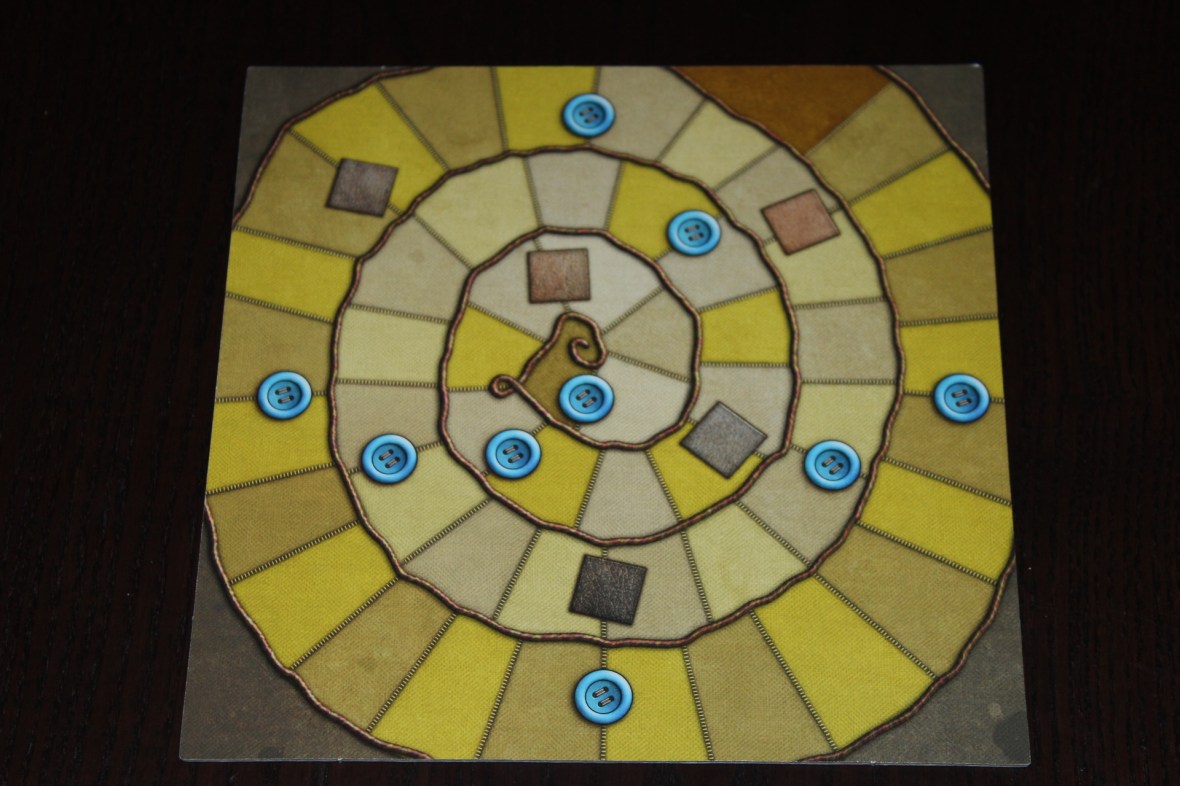
It’s something about the fact that the other side doesn’t have spots that are all the same size, even though MOST of the spots are the same size:
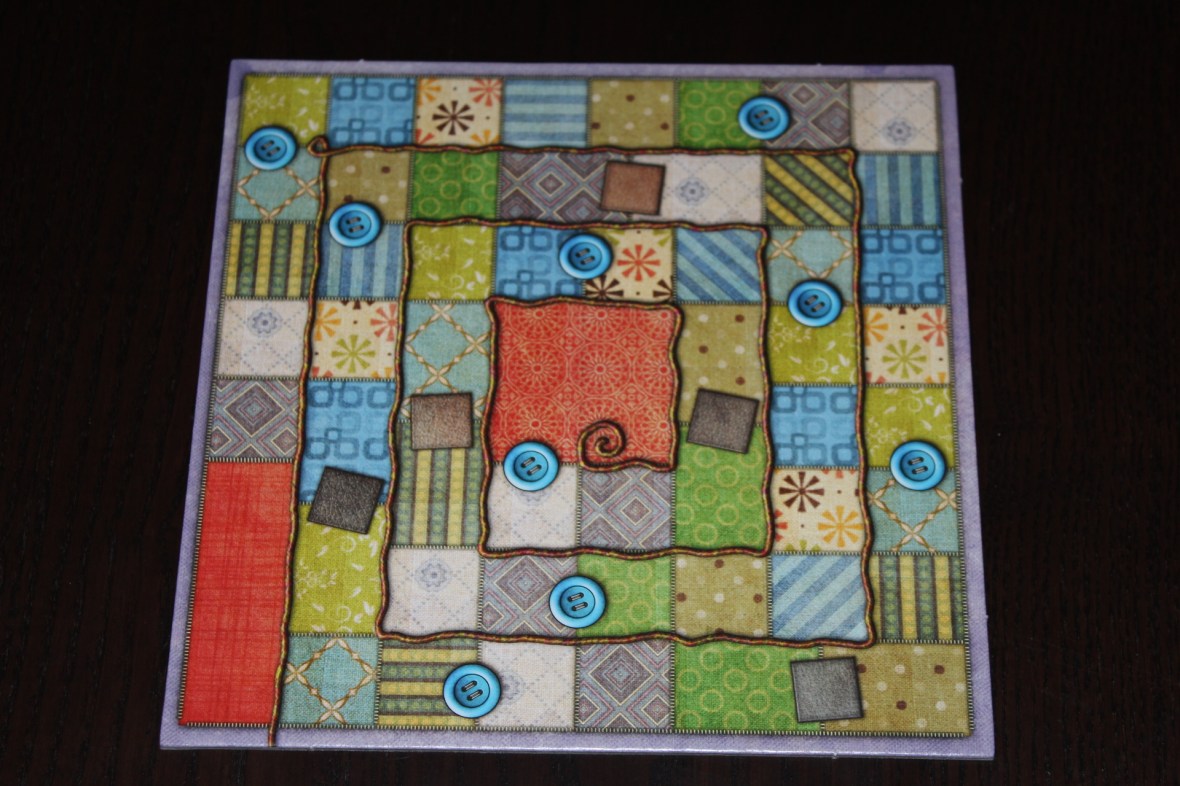
See how irritating that is? Though I definitely think it’s prettier, art-wise.
The two other boards are each player’s 9×9 quilt boards. They look like this:

There should also be a few tokens inside a small bag, like so:

The green and yellow ones are your player tokens, and they go on the time board (put the player going first’s token on top of the other; I’ll explain why later). Set aside the larger wooden token — that’s called the neutral player marker, and that’s used for the main gameplay. I’ll explain how in a second.
You’ll also likely notice that you have a lot of tiles:
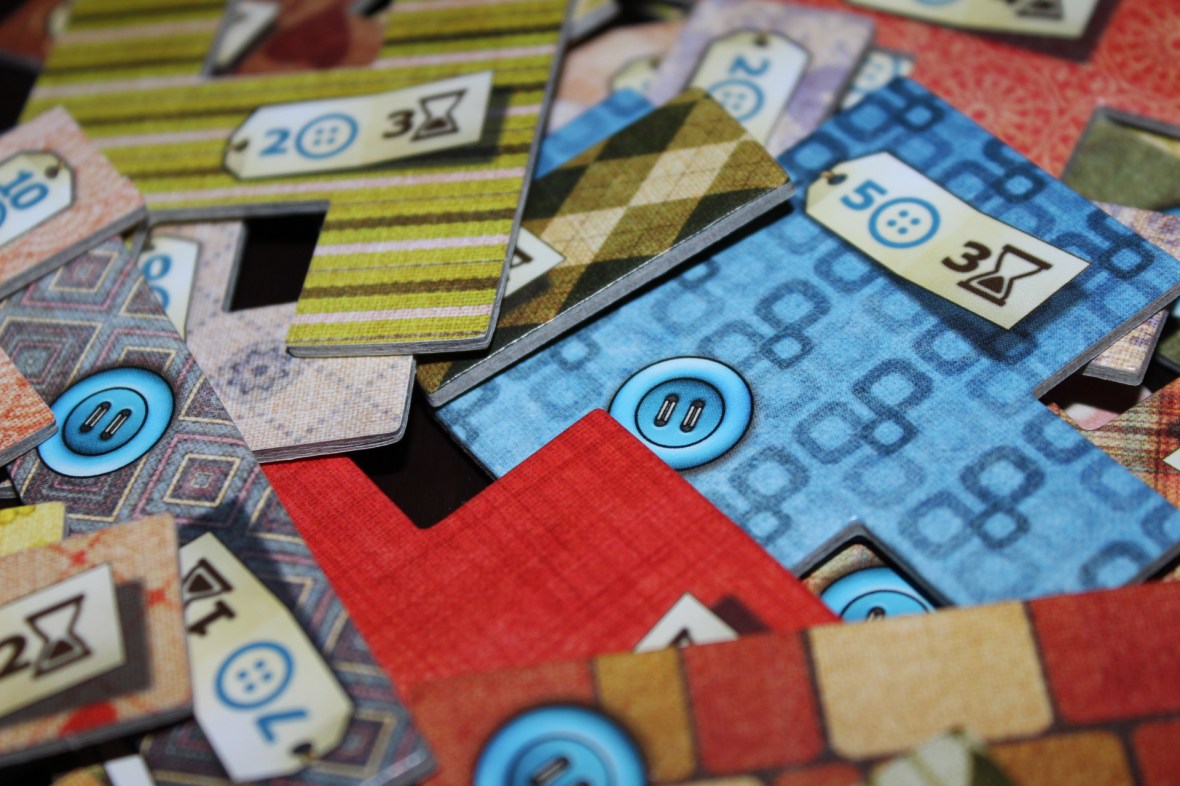
Take or dump them out (however ceremoniously you choose to do so). There should be five small single-square patches, which conveniently go on the time board on the five single-square patch spots. It’s almost like this was planned. Take the remaining tiles and put them in a random circle around the time board (note that it probably won’t be super close to the time board since there are a lot of tiles). These are your patches. Find the 2×1 patch (it’s only one square tall and two wide; it’s the smallest piece) and place the neutral player marker in front of it (clockwise), like so:
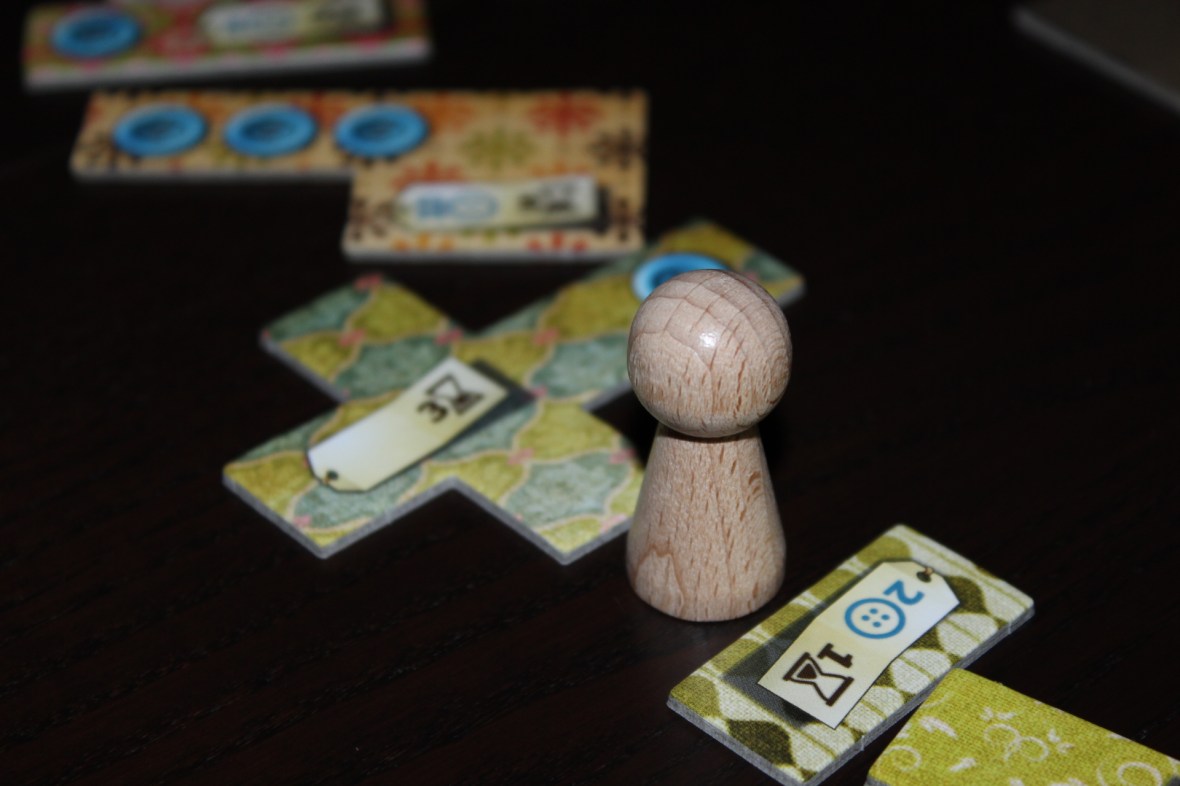
Finally, dump out all the buttons and give each player five (preferably five of the single buttons rather than one of the five button pieces, but you do you). That’s your starting button count.
When your play area looks like this, you’re ready to begin:
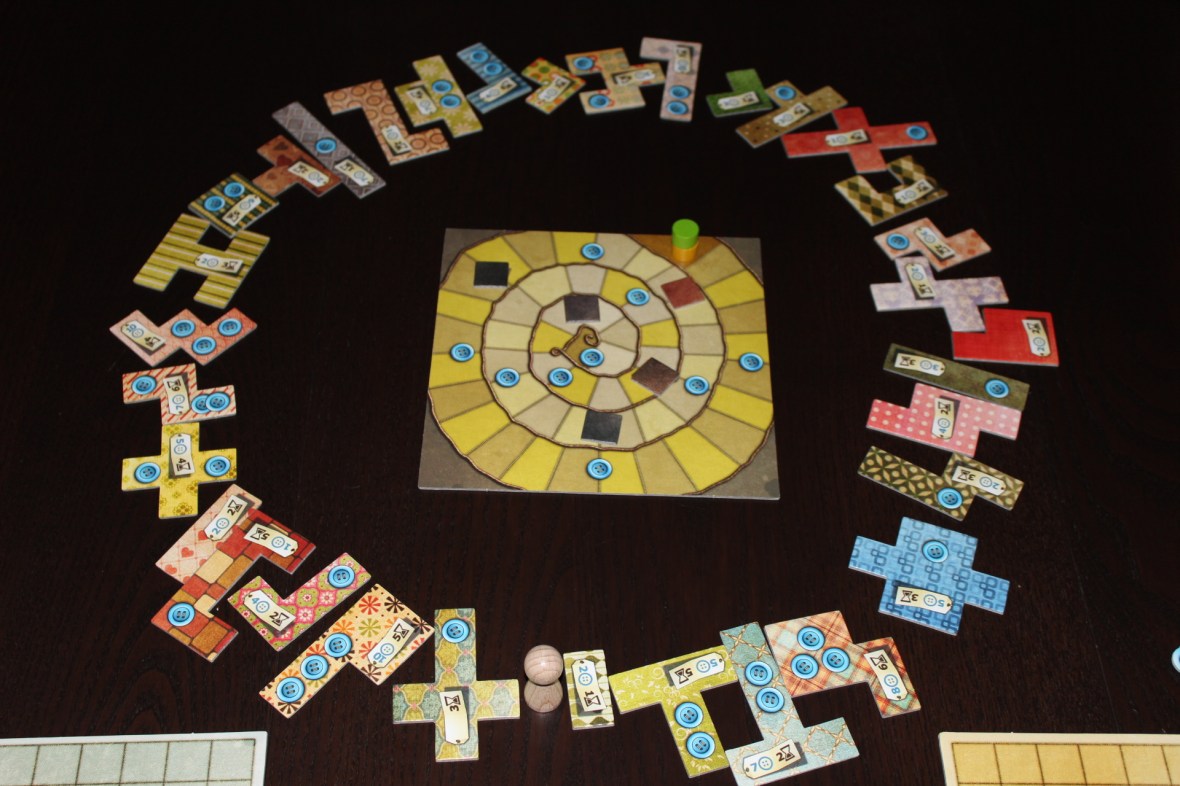
Now whoever you chose to be first goes first. Let’s talk about how the game goes.
Gameplay
So, the cool thing is that this game plays very similarly to Tokaido, in the sense that whichever player is further back on the time board goes next, and this means that you might not have the same number of turns as your opponent. So let’s talk about that. On your turn, you can do one of two things:
- Move your piece in front of your opponent’s. You collect one button for each space that you move. So if you are two spaces behind your opponent, you would collect three buttons to move in front of them.
- Take one of the three pieces in front of the neutral player marker, pay for it, and add it to your quilt board. You can buy a patch if you can afford it and add it anywhere on your quilt board that you’d like, provided it fits on the board and doesn’t cover any other pieces. The blue cost is buttons; so you have to pay for every piece (with one exception). However, there’s also a brown number, which enterprising readers might have already assumed was a time cost. I am told by quilting subject matter experts that quilting requires time and money (usually) to complete, so this makes sense. You pay time by moving up on the time board. Note that if you move such that your piece shares a space with your opponent, put your piece on top of theirs. You will get to take another turn since you “arrived later”. Neat! Finally, put the neutral player marker in the space that used to have the tile you just bought. This means that a different set of tiles will be available to purchase on the next turn, but you can only ever purchase the three tiles in front of the player marker. If you can’t afford any of them, then you cannot buy and must go with Option 1 for your turn. Tough.
In EITHER case, if you pass a button on the time board you collect buttons for every button on a patch on your quilt board (think of it as income). If you pass a single-piece patch square, you take that patch and add it to your board, for free. Note that both players earn buttons when they pass a button, but only the first player to pass the single-piece patch earns it. Also note that the first player to have a complete 7×7 square covered earns the 7×7 bonus tile (which cannot be added to your quilt board; it’s just a bonus), giving them 7 extra buttons when the game ends.
Play concludes when both players reach the center of the time board (and pass the final button threshold). To determine the winner, count your buttons and subtract two buttons for every square uncovered on your quilt board. Ouch. Add the extra seven buttons if you got the bonus. Player with the most buttons wins, but if you tie and need a tiebreaker, whoever got to the center first wins.
For a lot of people, your first score will be negative. That’s just life in the city, in the cruel underworld of competitive quilting.
If you’d prefer to avoid a negative score, let’s talk strategy (but no guarantees).
Strategy
Yeah, we played kind of haphazardly my first game, so it was -2 to -6. We figured it out a bit more, but usually there’s an upward trend in scores. There are people on Instagram scoring > 30, which seems suspiciously like witchcraft to me. But who am I to judge?
- Get tiles with buttons on them. You figure this is obvious, but since tiles are priced with their size and buttons in mind, some players tend to think that going for cheaper tiles is a better strategy and ignore the fact that there are eight income buttons on the time board. That’s a lot of income once you start getting > ten buttons per income. Also it helps you buy more expensive tiles later in the game, as well as giving you extra points once you hit the last space of the game.
- Don’t forget the uncovered space penalty. I tell people, “there are 81 spaces on the board, each worth -2 at the end of the game. You start with 5 buttons. So really, you’re just starting the game with a score of -157.” You should be mindful of that when you play. For instance, last game I played I bought mostly small pieces (not completely by choice), so even though I had a higher income than my opponent I had fourteen uncovered spots to her five, so I got crushed in the endgame. While buying buttons is nice, buying tiles that cover a lot of space is nice as well. This is also good to keep in mind when you’re going for the 7×7 tile. It’s nice, but it’s only worth 7 buttons (slightly more than three covered spaces). If you’re going to lose the 7×7 tile and cover six or seven spaces, it might just be worth it. In fact, the Patchwork app just starts you at -157 points and lets you count upwards.
- Figure out how to trap your opponent. Like Tokaido, the best thing you can do is leave your opponent unable to act. This can happen if you notice that on your opponent’s next turn they won’t be able to buy anything with their current button count. This means on your turn, you may want to just jump in front of them and take buttons since they can’t buy on their next turn. Your opponent may also buy a piece that they don’t want, just so that they can buy something, which may also be good for you.
- Taking multiple turns can be good, but always be mindful of where you’re going to finish up. You don’t really want to spend all your money if you’re not going to cross an income space for a while, since it means you’re vulnerable to getting trapped by your opponent. Sometime’s it’s just better to use the extra turn to gain more buttons and move in front of your opponent. A particularly outcome is spending all your money and finishing up on the space before an income button, such that you won’t even earn much when you next get to move.
- The single-patch pieces are super handy. Try to get them if possible, as they’re not only a free 2 points (since they cover a patch) but can help fill in really tricky squares (and work towards the 7×7). They tend to help you correct mistakes or bad luck, so I’m a pretty big fan of them. Plus, if you get them all it makes it difficult for your opponent to take the 7×7 from you.
- That being said, try not to leave single-patch holes in your quilt. Better to be safe than sorry, so I usually recommend trying to keep your options open for as long as possible. Note that if you can’t play any tiles (they don’t fit on your board), you must just move forward on your turn, which isn’t necessarily the best thing, since you can’t play any more tiles.
- Try to think a couple moves ahead. When picking a piece, think about what options you’re giving your opponent based on the piece you pick and try to reason what they’re likely to take. That way, you can figure out what your options will be next turn and try to synergize your selection somewhat. Be particularly mindful if the next turn will be yours or if you’re giving your opponent two turns, as that could significantly change your expectation.
Pros, Mehs, and Cons
Pros
- Short and easy to learn. It’s pretty straightforward; it’s more the strategy that gets a bit difficult since you’re trying to outthink your opponent.
- Really cool theme. It’s not something I’ve seen before and it’s very unique, which is nice for getting people interested in trying it. Usually I just get an eyebrow raise when I’m asking, “what are your thoughts on competitive quilting?”, and then they’re pleasantly surprised by what is a high-quality game.
- Nice art. The pieces are cute and colorful, and the whole game has a loving whimsy to it. It’s pretty nice, actually.
- Tile-laying. I remain consistent in my love for games that involve laying tiles, but this one has a competitive puzzling element to it that makes it particularly gratifying (since the “tiles” are not all the same shape like Carcassonne)
- I really like the luck-mitigation element of only looking at a sliding window of patches. I think it’s really interesting, since you can see all the tiles at the beginning but can only buy the three in front of the neutral player marker. The sliding window means that you have to contextualize your moves against the larger set of available pieces rather than just getting screwed with an unlucky draw (or at least giving you some options, though they might all be bad).
- Fun to look at quilts once you’re done. I mean, what’s not to like?
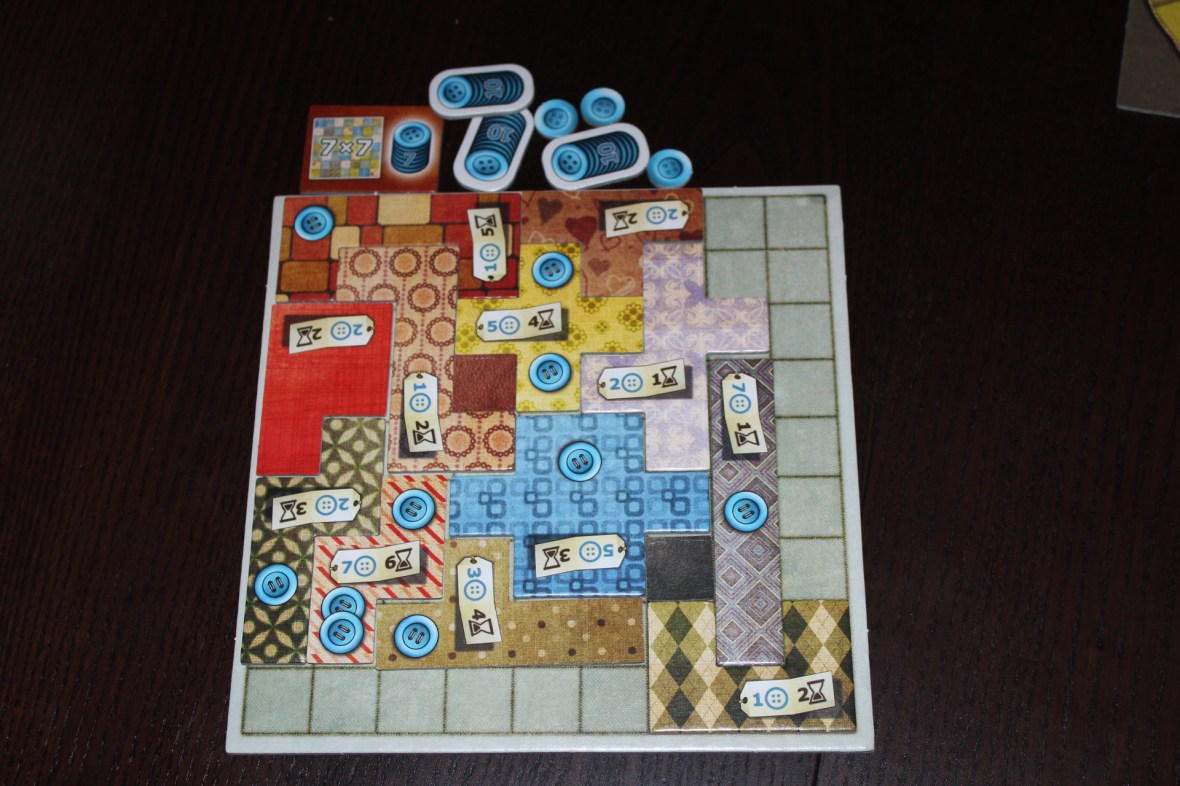
Mehs
- Pieces are a bit flimsy. Thicker cardboard would have been nicer, but I think that’s just because I’m spoiled by Kickstarter games like Burgle Bros.
- That one side of the tile board is confusing and I want to complain about it again. It’s just odd! But a better design. Sigh, trade-offs.
- The rules kind of imply that you’re going to have a really good first game. I’ve only seen one person get a positive score on their first game, but the example in the rules has a 14 – 11 game, which caused some concern when we first played, as we figured we must have gotten the rules wrong. Nope! We just suck.
Cons
- Getting a negative score your first game can be a huge bummer. Thankfully my group trusts me pretty well when it comes to my opinion on board games (for some reason?), so they weren’t discouraged by our initial playthrough of this. That being said, I could see this not going over well with someone that you’re trying to get into board gaming. Maybe save this game for after you’ve sold them on the hobby?
- The random patch layout generation in the beginning of the game is crappy. It’s just not a real thing, as you’re trying super hard to not think about the pieces as you lay them down “randomly”. I could be more in favor of it if they had a tile bag (like Roll for the Galaxy or Isle of Skye, though I think I have made my love for tile bags and tile games in general known) such that you couldn’t see the pieces you were drawing, but my ziplock bag that I’m using for tiles is completely transparent. It worries me that I might subtly influence the piece order or something dumb, though it seems very difficult to do that in a way that it would matter (unless the first three tiles all cost more than 5 buttons, but that just seems like bad luck). I’m not convinced there’s a better way to do this, but I’m not a fan.
Overall: 8.75 / 10
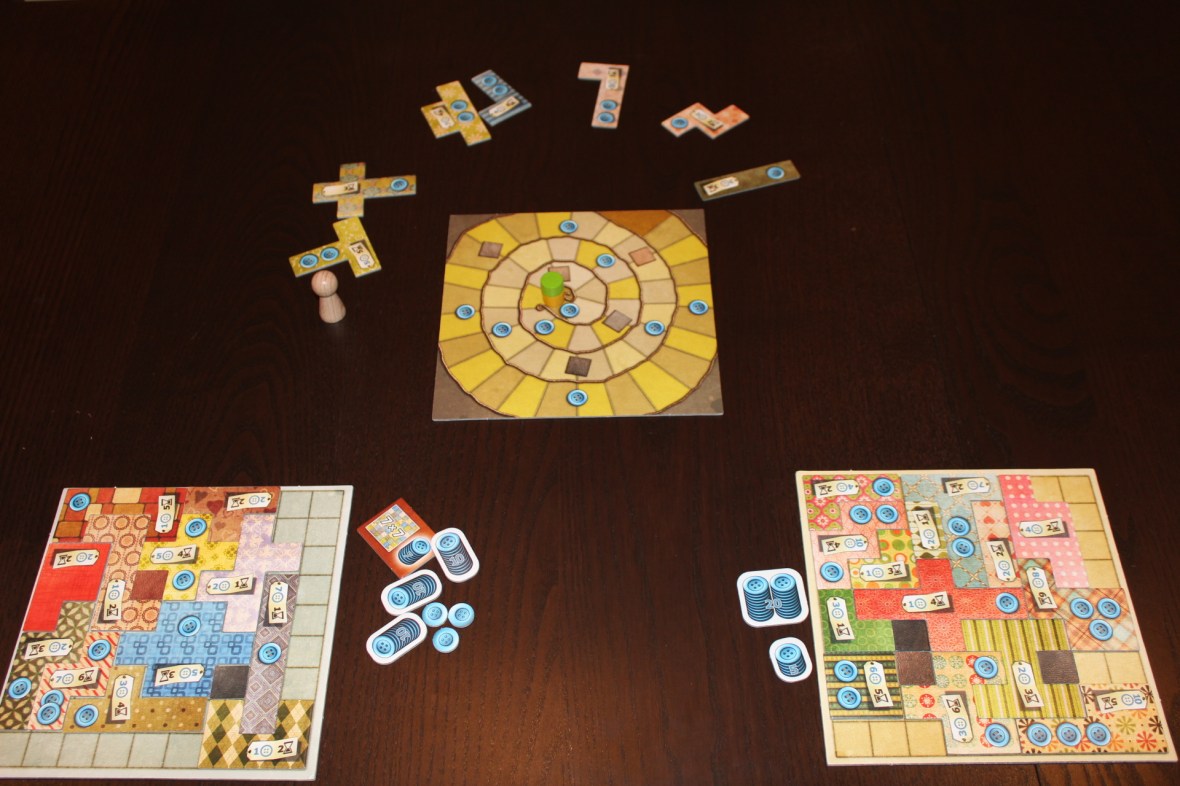
You know? Patchwork is a solid game that’s excellently locked at a two-player count, meaning you can sit down with a friend and quilt it out. I think it adds a lot of variety to any collection both in terms of theme but also in terms of smart gameplay. It’s almost like competitively trying to make a puzzle, but the other player can steal pieces that you want, which makes it really challenging but also fun! I’d strongly encourage anyone looking to try out a two-player only game to add it to their collection, though I’ve heard an app is on the way…
And, indeed, it is.
Hi, Eric. Thanks for this review. I enjoyed your jovial tone for one thing, but it was also helpful to get more insight into this title. I agree there seem to be a number of new and unusual themes hitting the market these days like this one and Tokaido. Far Off Games (makers of Xia) are in production on a surfing-themed game. I like it. Adds diversity to the choices out there and a nice change of pace from the classic “war” or “finance” themes.
Also appreciate your referencing Carcassonne, as I have been obsessed with this one as of late, especially on my phone. A Patchwork app may be just the next thing for me.
LikeLiked by 1 person
I’ve been playing this for half of the weekend and keep winning (hence the continuation of playing ^^). Love it! But you’re right about the one side of the scoreboard, I like looking at it as well because of its colourfulness, but damn, it’s just confusing.
LikeLike